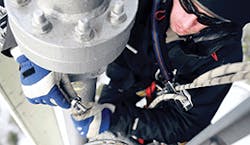Safety professionals continue to build enduring cultures of safety to ensure the health and well-being of their workers. In 2016, the outlook for success amid the difficulties and opportunities of such efforts remains, in a word, positive, but with the caveat that the storm clouds of challenges we all know so well show no signs of dissipating.
As busy and rewarding and difficult as the past few years have been, expect the new year to be even more so. Here's a quick overview of what to expect in terms of the good and the not-so-good:
1. Investments Are Paying Off
The good news is that corporate investments in safety, health and environmental (SHE) programs are paying off and will continue to do so on multiple levels.
According to a survey Honeywell conducted among safety professionals, most safety managers view the current state of their SHE programs – the foundation of every successful corporate culture of safety – as strong: defined as exemplifying best practices, achieving full compliance, working better than the rest or at least reaching general satisfaction. Few complain that their programs need major improvements.
2. Strong Support From the C-Suite
Corner office support is growing. In more and more companies, a thumbs-up enthusiasm for SHE efforts is growing, with support for a strong and enduring culture of safety emanating from C-level executives.
Senior management attention and support mean devoting the time and resources critical to the success of a corporate safety culture by ensuring that SHE programs are done correctly. While their executives are busy, many safety managers report that executives are devoting their attention to the cause when they can. Peer managers in other departments also are supportive. The result? Workers recognize commitment "from the top" and appreciate their company's SHE program as an essential part of their own day-to-day work.
3. Safety Is Generating Dividends
Success is reaching the bottom line. Perhaps that corner office support is due to the recognition that a positive culture of safety generates dividends that extend well beyond worker safety. Safety managers know that positive safety results are reflected in the operational and financial performance of an organization.
In fact, many report a direct correlation between a strong SHE program performance and a solid financial performance.
4. Training Remains Critical
Training will continue to be a critical component of positive corporate safety cultures. To those safety professionals who see worker safety as their No. 1 goal – as opposed to those who see SHE programs as protection from corporate liability – safety training will continue to be considered nothing less than an essential investment in all programs.
A positive, nurturing trend is the growing emphasis on behavior-based initiatives and programs. These are aimed at reinforcing safe behavior, versus efforts that merely focus on ensuring that employees know and follow rules and regulations. State-of-the-art training facilities featuring catwalks, climbing towers, confined space simulators, wind simulators and other equipment provide immersive experiences to simulate hazardous work environments in a range of industries.
5. Risk Assessment Remains Important
Risk assessment programs are at risk. Risk assessment programs seem to be one area in need of improvement. While most safety managers say they understand and routinely use the term "risk assessment" in their SHE efforts, many report that they are not satisfied with their programs or the amount of training.
Not surprisingly, regulatory compliance, at least in some form, will persist in impacting virtually all programs.
6. Globalization Remains Challenging
Globalization continues to challenge. Many organizations with global or international operations still report differences in their safety culture across borders.
More likely than not, safety managers in such entities who are struggling to achieve a single, unifying safety culture (while adjusting for local standards) will continue to do so.
7. Workloads Are Growing
Most safety managers expect their current heavy workloads to further increase. The obstacles in 2016 are well known to all: lack of time, staff, funding, training and accountability.
Moreover, as the tides of regulation and global corporate consolidation continue to rise – along with the responsibilities of safety professionals – ongoing economic difficulties could result in further safety staff or budget reductions. The challenge for safety professionals is both familiar and growing: to continue to do even more with even less on all fronts, from training programs to the processing of paperwork.
In 2016, safety professionals should look to two key points as encouragement from past programs as well as touchstones for new efforts. First, a majority of employees believe that SHE is an essential part of their own work. In other words, workers successfully are internalizing the messages and practices of their safety cultures. Second, more often than not, a company's safety performance is viewed as wielding a major impact on operational and financial performance, so corporate management is continuing to increase both appreciation and support.
Most safety professionals view compliance as the minimum goal for their SHE programs and are striving to move beyond the basics to build best practices-based cultures of safety.
As real challenges loom ahead in 2016, we should all build on the positives to ensure the success of a goal that is right and a cause that is noble.
John Montigny is vice president and general manager of Honeywell Industrial Safety (HIS), part of Honeywell Automation and Control Solutions. HIS helps organizations with connected, real-time safety intelligence to respond to safety threats, manage risk to the business and improve productivity. In addition to offering a broad range of industrial safety products – from personal protective equipment to software to gas monitoring – HIS helps organizations make better decisions by connecting sensors throughout customers' operations to deliver an accurate picture of safety at all times.

